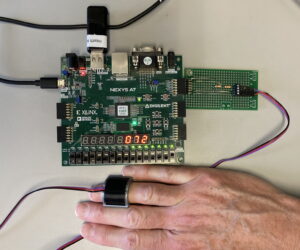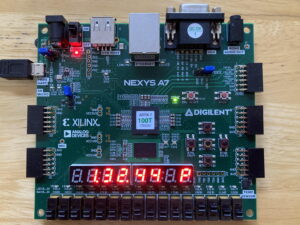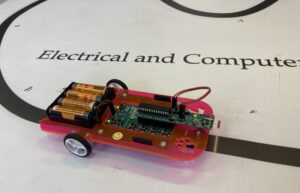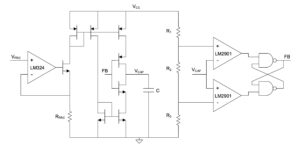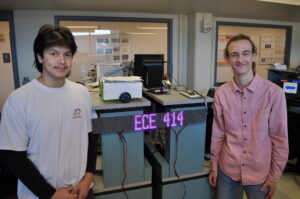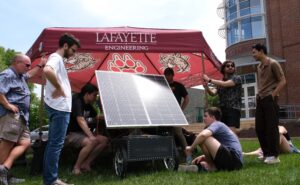Engineering Design in ECE
Engineering design is the process of creating a system, component, or process that meets a set of needs known as requirements.
In Electrical and Computer Engineering, this involves understanding the problem to be solved and coming up with a technical solution to the problem that is feasible in terms of cost and performance. ECE students at Lafayette gain experience in design starting in introductory courses and culminating in a Senior Design Project in which students draw on knowledge from their prior courses to address a significant technical problem. This page describes some of these experiences.
ECE 211 Digital Circuits I
Students analyze and design digital circuits in the SystemVerilog hardware description language. In the laboratory section of the course, students prototype designs of increasingly complex digital circuits on an FPGA. Students take their projects from specification to implementation and interface with both analog and digital peripherals. Design projects include a heart rate monitor that interfaces with an analog pulse sensor. The course emphasizes design using common digital building blocks to create a circuit that meets specifications.
ECE 212 Digital Circuits II
ECE 212 builds on the fundamentals of ECE 211 to focus on implementing more complex digital systems with an emphasis on general-purpose computers. The laboratory experience culminates in the implementation of three unique processor designs in SystemVerilog. Given the complexities of these projects, students work at a higher level of abstraction and leverage block-level diagrams during the design process. Components are developed to be modular and reused across the processor implementation. Further, ECE 212 introduces the concepts of performance testing and measurement, as students evaluate the performance and area of their implementations.
ECE 221 Basic Electric Circuit Analysis
In ECE 221 students build a two-channel Pulse Width Modulation (PWM) circuit to control the DC motors that drive the wheels of a small line-following robot. The project aims to provide hands-on experience in building electronic circuits, basic soldering skills, PCB circuit layout design, understanding PWM functionality, sensor calibration, and understanding how high-level circuits are built up from simple building block,
ECE 322 – Introduction to Solid-State Circuits and Devices
The ECE322 lab features a laser audio transmission project which has a transmitter board which converts microphone audio signals to intensity modulated light for long distance transmission and a receiver board that senses the modulated light signal and converts it to audio via a speaker. The experimental installation includes fixed mount microphone, laser, photodetector, and speaker at each end of the ECE department hallway for bidirectional communication. The transmission distance is approximately 75 meters (250 ft). Experiments like speed of light vs. speed of sound are easily demonstrated over this distance. This project includes many concepts from the first semester of analog electronics such as AC/DC coupling and superposition, biasing and small-signal modeling, and transistor and opamp applications. It includes modeling of microphones, laser transmission attenuation, and photodetection devices. It also requires computer aided schematic capture and simulated verification of transmitter and receiver circuitry proving correct design to specifications prior to prototype builds. The project concludes with student hand prototyped transmit and receive circuit boards which plug into the hallway interconnect boxes.
ECE 323 – Analysis and Design of Solid-Sate Circuits
In ECE323, students experience mixed-signal and nonlinear analog phenomenon based on a project sequence of oscillator design. The first oscillator studied includes analog and digital techniques to create a voltage-controlled mixed-signal relaxation oscillator (VCO) that also features design concepts from integrated CMOS transistor technology. The second oscillator project is based on linear system stability theory and nonlinear limit cycle dynamics to produce an analog feedback oscillator via a Barkhausen criterion requirement. Each of these design projects require a design to specification with CAD schematic capture, simulation, and prototype builds. The mixed-signal oscillator project also features a printed circuit board (PCB) CAD flow with student designed PCBs electronically exported to an external professional PCB fabrication company.
ECE 414 Embedded Systems
ECE414 provides an immersive, design-centric approach to embedded systems. Students undertake a series of increasingly complex design projects throughout the semester, culminating in a final project of their own
conception. These projects involve both hardware and software design, requiring students to interface microcontrollers with sensors, actuators, and other peripherals. Students follow a comprehensive design process, including specification, architecture design, detailed design, system integration, and testing. The course emphasizes practical skills such as reading datasheets, debugging hardware and software, and optimizing designs for performance and power consumption. Through these hands-on experiences, students develop the design skills essential for designing real-world embedded systems.
ECE 491-492 Senior Design Project
The year-long ECE Senior design project (ECE 491 – 492) introduces the basics of open-ended and team-based project engineering for students to gain skills that will prepare them for entry into the professional engineering workforce. Students are required to integrate and apply their knowledge of various topics from the ECE curriculum and to learn new material, including multidisciplinary material outside ECE, to propose their solution and implement their design for the project.
Successful project completion will require independent and team design work. Project management techniques, engineering ethics, and intellectual property are introduced and discussed in the courses. Written and oral communication skills are emphasized throughout the project. Students will apply their knowledge and skills to create an inclusive team-oriented working environment, follow a formal, requirements-oriented design process, and employ project management techniques to manage the design progress. The course culminates in a formal critical design review, acceptance testing, demonstration, and delivery.
Some recent ECE Senior Design Projects include:
- Biometric autonomous droid (AY 2021 – 2022)
- Battery management system for electrical vehicle (AY 2021 – 2022)
- Remotely accessible portable solar charging evaluation system (AY 2022 – 2023)
- Marge traffic device (AY 2023 – 2024)
- Autonomous wheelchair (AY 2024 – 2025)
- Smart living environment for people with limited mobility (AY 2024 – 2025)
